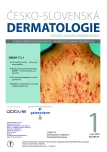Registry of Biological/Targeted Therapy BIOREP – Summary Report 2019
Authors:
M. Kojanová 1; P. Cetkovská 2; J. Fialová 1; J. Štork 1; S. Gkalpakiotis 3; P. Arenberger 3; A. Machovcová 4; T. Doležal 5; Biorep Skupina A
Authors‘ workplace:
Dermatovenerologická klinika VFN a 1. LF UK, Praha, přednosta prof. MUDr. Jiří Štork, CSc.
1; Dermatovenerologická klinika FN a LF UK, Plzeň, přednosta prof. MUDr. Karel Pizinger, CSc.
2; Dermatovenerologická klinika 3. LF UK a FNKV, Praha, přednosta prof. MUDr. Petr Arenberger, DrSc., MBA
3; Dermatovenerologické oddělení FN v Motole, Praha, primář MUDr. Alena Machovcová, Ph. D., MBA
4; Value Outcomes, Praha
5
Published in:
Čes-slov Derm, 95, 2020, No. 1, p. 16-22
Category:
Pharmacologyand Therapy, Clinical Trials
Overview
Background and objectives: Evaluation of patients included in the registry of biological/targeted therapy BIOREP in the Czech Republic.
Methods: We performed a retrospective evaluation of patients enrolled in the registry BIOREP to date 31. 12. 2019. The aim of our study was to evaluate patients on biological/targeted treatment in the given period in individual categories and to analyse the population of patients with psoriasis.
Results: To 31 December 2019, a total of 2,568 patients were enrolled in the BIOREP registry, 94.7 % were patients with psoriasis, 5.1 % with hidradenitis and 0.3% were patients with off label treatment. Of the psoriasis group, 62.9 % of patients were men. The average patient age at the end of 2019 was 51.9 years, the mean age at the time of diagnosis was 24.7 years, and the age at first biological/targeted treatment was 46.2 years. More than 75% of patients were overweight or obese and 28.9% of patients were smokers. The comorbidities occurred in 71.2% of patients, the most common disorder was metabolic/endocrine disease (53.5%) and cardiovascular disease (53.4% of patients). Of the different comorbidities, hypertension, dyslipidemia and diabetes mellitus were the most common. Psoriatic arthritis was observed in 37.1% of patients. In 2019, the average time from diagnosis to the introduction of biological treatment was 21.5 years, the average duration of biological/targeted treatment was 5.4 years. A total of 331 patients have already discontinued treatment and the average duration of their treatment was 3.7 years. On the average, the total duration of psoriasis was 27.2 years. Of the patients treated at the end of 2019, more than half (56.5%) were in the first line treatment.
Conclusion: BIOREP is the first registry of patients with psoriasis treated with biologics in Central and Eastern Europe. Our results found a similar or even higher prevalence of comorbidities and long disease duration before biological treatment introduction among patients included in European registries.
Keywords:
Psoriasis – registries – biological therapy – BIOREP
Sources
1. AUGUSTIN, M., SPEHR, C., RADTKE, MA. et al. German psoriasis registry PsoBest: objectives, methodology and baseline data. J Dtsch Dermatol Ges, 2014, 12, p. 48–57.
2. EGEBERG, A., IVERSEN, L., GNIADECKI, R. et al. Characteristics of patients receiving ustekinumab compared with secukinumab for treatment of moderate-to-severe plaque psoriasis – nationwide results from the DERMBIO registry. J Eur Acad Dermatol Venereol, 2017, 7, p. 1183–1187.
3. EGEBERG, A., OTTOSEN, M. B., GNIADECKI, R. et al. Safety, efficacy and drug survival of biologics and biosimilars for moderate-to-severe plaque psoriasis. Br J Dermatol, 2018, 2, p. 509–519.
4. GNIADECKI, R., BANG, B., BRYLD, L. E. et al. Comparison of long-term drug survival and safety of biologic agents in patients with psoriasis vulgaris. Br J Dermatol, 2015, 1, p. 244–252.
5. GNIADECKI, R., KRAGBALLE, K., DAM, T. N. et al. Comparison of drug survival rates for adalimumab, etanercept and infliximab in patients with psoriasis vulgaris. Br J Dermatol, 2011, 5, p. 1091–1096.
5. ISKANDAR, I. Y., AAHCROFT, D. M., WARREN, R. B. et al. Demographics and disease characteristics of patients with psoriasis enrolled in the British Association of Dermatologists Biologic Interventions Register. Br J Dermatol, 2015, 173, p. 510–518.
6. MENTER, A., PAPP, K. A., GOODERHAM, M. et al. Drug survival of biologic therapy in a large, disease-based registry of patients with psoriasis: results from the Psoriasis Longitudinal Assessment and Registry (PSOLAR). J Eur Acad Dermatol Venereol, 2016, 7, p. 1148–1158.
7. MOURAD, A., STRAUBE, S., ARMIJO-OLIVO S. et al. Factors predicting persistence of biologic drugs in psoriasis: a systematic review and meta-analysis. Br J Dermatol, 2019, 3, p. 450–458.
8. POGÁCSÁS, L., BORSI, A., TAKÁCS P. et al. Long-term drug survival and predictor analysis of the whole psoriatic patient population on biological therapy in Hungary. J Dermatolog Treat, 2017, 7, p. 635–641.
9. VILARRASA, E., NOTARIO, J., BORDAS, X. et al. ORBIT (Outcome and Retention Rate of Biologic Treatments for Psoriasis): A retrospective observational study on biologic drug survival in daily practice. J Am Acad Dermatol, 2016, 6, p. 1066–1072.
Labels
Dermatology & STDs Paediatric dermatology & STDsArticle was published in
Czech-Slovak Dermatology

2020 Issue 1
Most read in this issue
- Chronic Pruritus: The Status Quo and Prospects
- Registry of Biological/Targeted Therapy BIOREP – Summary Report 2019
- Bazaliom v koincidenci s lentigo maligna melanoma
- Red Maculopapules on the Left Side of the Neck – Tufted Hemangioma.
